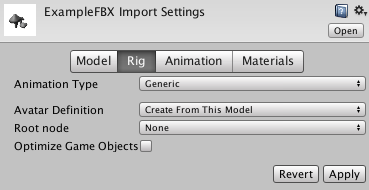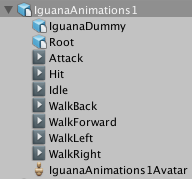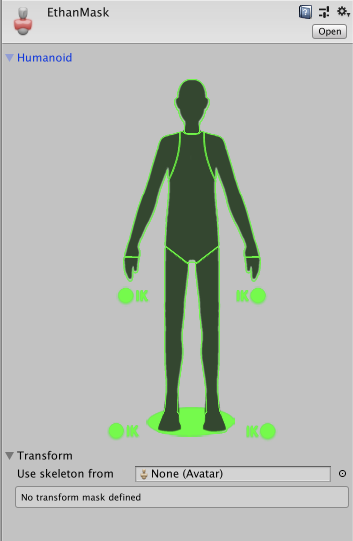Importing non-humanoid animations
A Humanoid model is a very specific structure, containing at least 15 bones organized in a way that loosely conforms to an actual human skeleton. Everything else that uses the Unity Animation System falls under the non-Humanoid, or Generic category. This means that a Generic Model might be anything from a teakettle to a dragon, so non-Humanoid skeletons could have a huge range of possible bone structures.
The solution to dealing with this complexity is that Unity only needs to know which bone is the Root nodeA transform in an animation hierarchy that allows Unity to establish consistency between Animation clips for a generic model. It also enables Unity to properly blend between Animations that have not been authored “in place” (that is, where the whole Model moves its world position while animating). More info
See in Glossary. In terms of the Generic character, this is the best approximation to the Humanoid character’s center of massRepresents the average position of all mass in a rigidbody for the purposes of physics calculations. By default it is computed from all colliders belonging to the rigidbody, but can be modified via script. More info
See in Glossary. It helps Unity determine how to render animation in the most faithful way possible. Since there is only one bone to map, Generic setups do not use the Humanoid Avatar window. As a result, preparing to import your non-Humanoid Model fileA file containing a 3D data, which may include definitions for meshes, bones, animation, materials and textures. More info
See in Glossary into Unity requires fewer steps than for Humanoid models.
- Set up your Rig as Generic.
- You can optionally limit the animation that gets imported on certain bones by defining an Avatar Mask.
- From the AnimationA collection of images that create a moving image when played sequentially. In Unity, an animation is the result of adding two different animation keys, at two different times, for the same animatable property. More info
See in Glossary tab, enable the Import Animation option and then set the other Asset-specific properties, . - If the file consists of multiple animations or actions, you can define specific frame ranges as Animation Clips.
- For each Animation ClipAnimation data that can be used for animated characters or simple animations. It is a simple “unit” piece of motion, such as (one specific instance of) “Idle”, “Walk” or “Run”. More info
See in Glossary defined in the file, you can:- Set the pose and root transform
- Optimize looping
- Add curves to the clip in order to animate the timings of other items
- Add events to the clip in order to trigger certain actions in time with the animation
- Discard part of the animation similar to using a runtime Avatar Mask but applied at import time
- Select a different Root Motion Node to drive the action from
- Read any messages from Unity about importing the clip
- Watch a preview of the animation clip
- To save your changes, click the Apply button at the bottom of the Import Settings window or Revert to discard your changes.
Setting up the Rig
From the Rig tab of the Inspector window, set the AvatarAn interface for retargeting animation from one rig to another. More info
See in Glossary (animation) type to Generic. By default, the Avatar Definition property is set to Create From This Model and the Root node option is set to None.
In some cases, you can change the Avatar Definition option to Copy From Other Avatar to use an Avatar you already defined for another Model file. For example, if you create a MeshThe main graphics primitive of Unity. Meshes make up a large part of your 3D worlds. Unity supports triangulated or Quadrangulated polygon meshes. Nurbs, Nurms, Subdiv surfaces must be converted to polygons. More info
See in Glossary (skin) in your 3D modeling application with several distinct animations, you can export the Mesh to one FBX file, and each animation to its own FBX file. When you import these files into Unity, you only need to create a single Avatar for the first file you import (usually the Mesh). As long as all the files use the same bone structure, you can re-use that Avatar for the rest of the files (for example, all the animations).

If you keep the Create From This Model option, you must then choose a bone from the Root node property.
If you decide to change the Avatar Definition option to Copy From Other Avatar, you need to specify which Avatar you want to use by setting the Source property.
Click the Apply button. Unity creates a Generic Avatar and adds an an Avatar sub-asset under the Model Asset, which you can find in the Project viewA view that shows the contents of your Assets folder (Project tab) More info
See in Glossary.

Note: The Generic Avatar is not the same thing as the Humanoid Avatar, but it does appear in the Project view, and it does hold the Root node mapping. However, if you click on the Avatar icon in the Project view to display its properties in the InspectorA Unity window that displays information about the currently selected GameObject, Asset or Project Settings, alowing you to inspect and edit the values. More info
See in Glossary, only its name appears and there is no Configure Avatar button.
Creating an Avatar Mask
You can apply masking to animation clips either during import time, or at runtime. Masking during import time is preferable, because it allows the discarded animation data to be omitted from your build, making the files smaller and therefore using less memory. It also makes for faster processing because there is less animation data to be blended at runtime. In some cases, import masking may not be suitable for your purposes. In that case, you can apply a mask at runtime by creating an Avatar MaskA specification for which body parts to include or exclude for an animation rig. Used in Animation Layers and in the importer. More info
See in Glossary Asset, and using it in the layer settings of your Animator ControllerControls animation through Animation Layers with Animation State Machines and Animation Blend Trees, controlled by Animation Parameters. The same Animator Controller can be referenced by multiple models with Animator components. More info
See in Glossary.
To create an empty Avatar Mask Asset, you can either:
- Choose Create > Avatar Mask from the AssetsAny media or data that can be used in your game or Project. An asset may come from a file created outside of Unity, such as a 3D model, an audio file or an image. You can also create some asset types in Unity, such as an Animator Controller, an Audio Mixer or a Render Texture. More info
See in Glossary menu. - Click the Model object you want to define the mask on in the ProjectIn Unity, you use a Project to design and develop a game. A Project stores all of the files that are related to a game, such as the Asset and Scene files. More info
See in Glossary view, and then right-click and choose Create > Avatar Mask.
The new Asset appears in the Project view:

You can now choose which bones to include or exclude from a Transform hierarchy and then add the mask to either an Animation LayerAn Animation Layer contains an Animation State Machine that controls animations of a model or part of it. An example of this is if you have a full-body layer for walking or jumping and a higher layer for upper-body motions such as throwing an object or shooting. The higher layers take precedence for the body parts they control. More info
See in Glossary or add a reference to it under the MaskCan refer to a Sprite Mask, a UI Mask, or a Layer Mask More info
See in Glossary section of the Animation tab.
- 2018–04–25 Page amended with limited editorial review
Did you find this page useful? Please give it a rating: